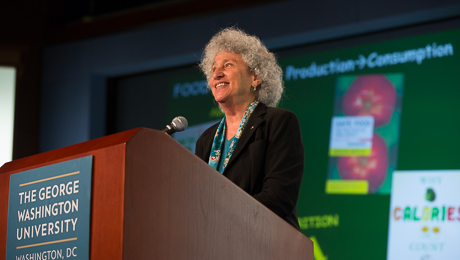Why do calories count?
This is what nutritionist Marion Nestle set out to answer in her newest book, named for this very question. The award-winning author, activist and New York University professor has also penned “Food Politics” and “What to Eat,” which also examine the politics of food and dietary choice. Throughout her research, she’s discovered one thing: The roots of food problems—like obesity, overeating and food scarcity—stem from a web of complicated yet closely entwined issues related to nutrition, public health and the food production industry.
“I’m completely convinced you can’t understand anything about why people eat the way they do unless you understand how our agricultural production system works and vice versa,” Dr. Nestle said.
She spoke specifically about urban food issues and their subsequent health consequences at a lecture held at the Jack Morton Auditorium on Tuesday. The event was sponsored by the George Washington University Urban Food Task Force, the Milken Institute School of Public Health and the Columbian College of Arts and Sciences.
“Marion Nestle is a role model and an inspiration to nutritionists, students, food lovers and activists around the world,” said Diane Robinson Knapp, chair of the UFTF.
Dr. Nestle shared that in the 1980s, Americans consumed 1900 calories a day. That figure now totals to 2100. Increased calorie consumption has correlated with higher obesity rates—roughly one-third of American adults qualify as obese, which raises costly health risks and diseases.
“Why are people eating more?” Dr. Nestle asked the audience.
The answer lies in deregulatory shifts that date back to the late 1970s and early 1980s, she said. The first change happened in the agricultural production sphere: Farmers were encouraged to grow as much produce as they possibly could, resulting in a hypercompetitive food market.
Wall Street was behind the second change. Shareholders who had stock in food companies demanded higher and more immediate returns on investment, further devastating a food industry struggling with heightened competition.
Food companies had to do something to respond. They got one break: President Ronald Reagan deregulated how food companies could market their products, particularly to children. Dr. Nestle explained that data published by Advertising Age shows just how much food companies ramped up their marketing expenditures. In 2013, the food industry paid advertising agencies $17 billion to encourage people to buy their products. The budget for Cinnamon Toast Crunch cereal alone was $35 million.
The food industry’s other efforts included opening more restaurants across cities, and lowering their prices. Both have made it easier to access unhealthy foods more easily, leading to damaging health consequences, particularly for low-income consumers.
“If you go to McDonald’s with $5, you can buy five hamburgers or one salad,” Dr. Nestle said. “If you’re poor and you’re hungry, which are you going to buy? It seems pretty obvious.”
A final deregulation affected health claims that have allowed food companies to market their products in surprising ways. For example, Dr. Nestle pointed out the example of chocolate Teddy Graham cookies. The sugary desserts contain calcium, iron and zinc, so they have been characterized as a “health food.”
In the 1980s, Americans also continued long-term trends of eating out more often, which means consuming more calories, and ordering bigger portions, fueled by food companies making sizes larger. All of these issues, not surprisingly, have resulted in higher calorie consumption and obesity rates, Dr. Nestle said.
The goals of the food industry, which wants to increase revenue, and public health professionals, who want to mitigate health risks, aren’t always congruent in practice. Dr. Nestle said she believes regulation is a solution if it’s done in a way that creates a level playing field for the food industry.
But in the face of First Lady Michelle Obama’s “Let’s Move!” Initiative and efforts from Mayor Michael Bloomberg to create a cap on soda sizes in New York, the food industry has fought back—with a vengeance. Dr. Nestle said their strategies have included everything from lobbying, blaming personal responsibility, arguing about the science behind health research and partnering with philanthropic and community groups.
Dr. Nestle said despite difficulty, there is plenty that people can do on an individual and social level. She encouraged the audience to advocate changes in policy and promote social responsibility. She also applauded efforts of groups like the UFTF, a group that she said is likely to be a major player in the burgeoning food movement.
“There’s plenty to do. There is no lack of advocacy that is needed. Take action. Do something. Now is the time,” Dr. Nestle said. “Vote with your fork.”
Following the lecture, Dr. Nestle continued spreading her wisdom to the GW community by visiting “The World on a Plate,” a course taught by chef and 2014 commencement speaker José Andrés. Dr. Nestle answered questions from students. She also discussed how although it is important to buy locally, it can’t always be done for all types of food.
“I thought her comments on eating entirely local were useful—there’s no way you can completely do that in the society we live in, but it’s good to know if you can get it local, you should buy it local,” junior Kathryn Leonard said.
Star Calaman, B.A’ 10, trekked from New York City to D.C. just to attend the lecture. Ms. Calaman, who was a finance major at GW, is in her first semester of culinary school. The class gave her insight on how intricate topics surrounding food are.
“This was really eye-opening. It makes you think of food in a completely different way—it’s not as simple as it appears,” she said.


